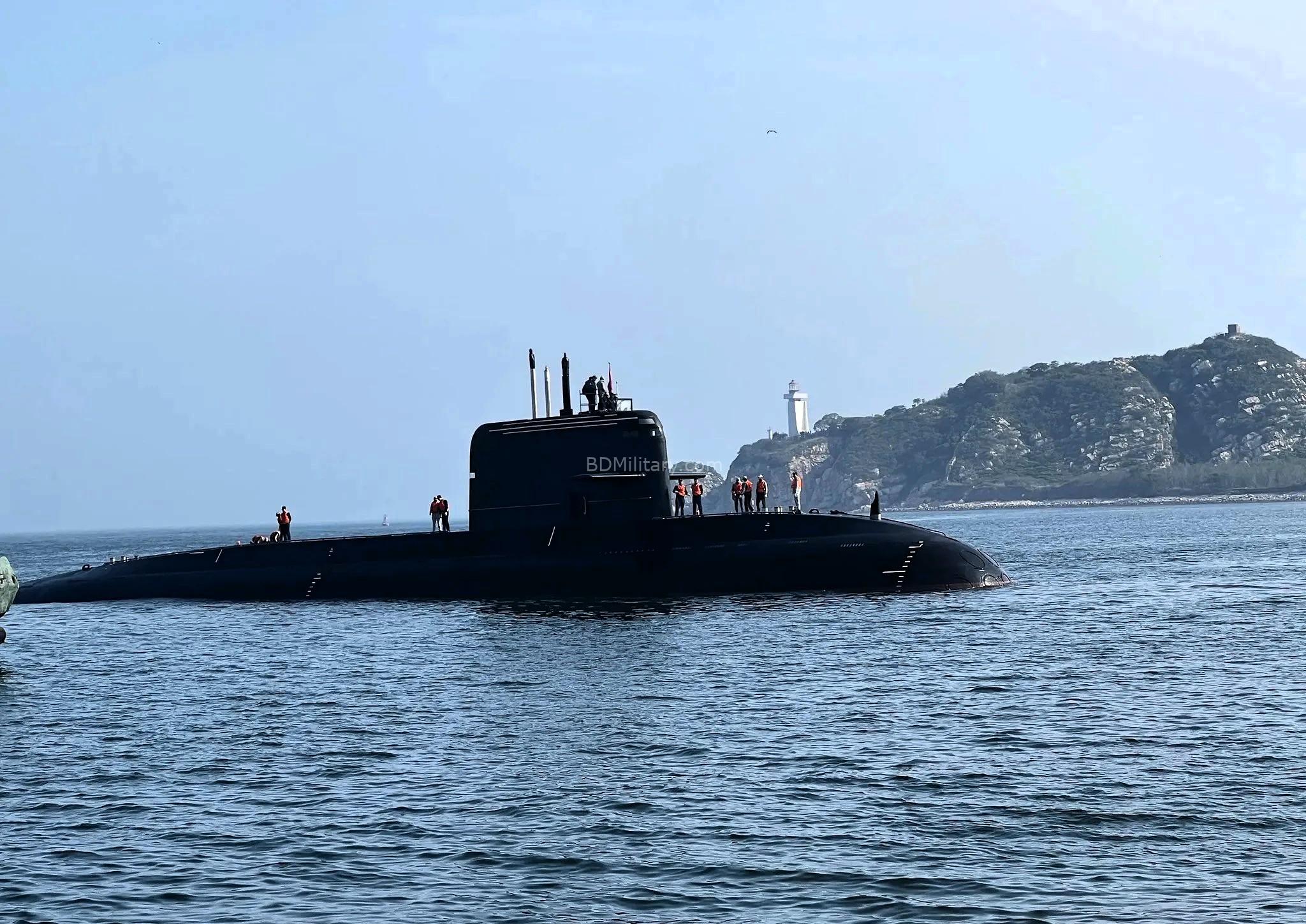The undersea domain has long been the quiet but decisive frontier of naval power in South Asia. While surface fleets attract headlines with carriers and frigates, true deterrence at sea lies beneath the waves — in submarines that can surveil, threaten and strike unseen. Over the past decade Pakistan has methodically pursued that advantage, and with the emergence of the Hangor-class air-independent propulsion (AIP) submarines the Pakistan Navy (PN) is set to consolidate a substantial qualitative edge over its principal regional rival, the Indian Navy (IN).
As of late 2025, Pakistan’s first Hangor-class boat has entered sea trials, the third has been launched and the keel of the sixth has already been laid. That tempo of construction is remarkable: by the time the programme reaches maturity Pakistan will operate eight Hangor boats plus upgraded Agosta-90B (Khalid-class) vessels, giving Islamabad a fleet of eleven AIP-capable submarines. India, by contrast, still has no operational AIP submarines as its Project-75I (P-75I) efforts linger and indigenous AIP work at the Defence Research and Development Organisation (DRDO) remains to be proven in service. The consequences of that asymmetry are strategically meaningful.
The Hangor Platform: A Cost-Effective Yet Potent SSK
Derived from China’s Type 039B (Yuan-class) design, the Hangor-class combines diesel-electric propulsion with an AIP system that permits extended submerged endurance. In practical terms this means patrols measured in weeks rather than days, which dramatically enhances stealth and persistence. Their armament—533 mm torpedo tubes able to launch heavyweight torpedoes, anti-ship missiles and potentially submarine-launched cruise missiles—gives them flexible strike options. Modern sonar suites, low acoustic signatures and improved electronic warfare packages complete the picture of a contemporary conventional attack submarine.
Perhaps equally important is the programme’s industrial model. Four boats are being built in China while four are assembled at Karachi Shipyard & Engineering Works (KSEW) under a substantive technology-transfer arrangement. That transfer not only accelerates Pakistan’s immediate force modernisation but also deepens its indigenous sustainment and construction capability — a force multiplier in the long term.
India’s Stalled Timetable and Industrial Friction
India’s submarine modernisation has been hindered by procurement complexity, stringent local-industry conditions and shifting policy frameworks. P-75I, envisaged as a six-boat class with AIP and advanced sensors, has been beset by protracted negotiations over transfer-of-technology and intellectual property, leaving the programme delayed. In parallel, India is considering construction of another three Scorpene-derived boats at Mazagon Dock Limited (MDL) as an interim measure and moving ahead with proposals to build several German-origin conventional submarines under separate arrangements. Meanwhile, the DRDO’s indigenous AIP effort has yet to demonstrate operational maturity for retrofit — creating a capability gap at a time when Pakistan is fielding operational AIP boats.
The effect is that, despite a far larger defence budget, India risks fielding a conventional submarine force that, by endurance and stealth metrics, will be inferior to Pakistan’s AIP-enabled fleet for the better part of the next decade.
Strategic Consequences in the Arabian Sea and Beyond
AIP submarines are central to modern sea-denial and area denial strategies. Their ability to stay submerged for prolonged periods makes them considerably harder to detect, increasing the survivability of the platform and the lethality of patrols. In maritime geographies such as the Arabian Sea and approaches to the Gulf of Oman, where maritime chokepoints and narrow sea lanes concentrate traffic, these submarines become particularly potent.
For Pakistan, Hangor-class boats allow persistent deterrent patrols and the ability to threaten high-value surface ships and maritime logistics routes. They also provide a credible platform for strategic strike options, which, if submarine-launched cruise missile capability is realised, would enhance Islamabad’s deterrence posture. Industrially, the KSEW-centric production model also widens Pakistan’s sovereign capacity to maintain and, potentially, export submarine technology.
Implications for the Bay of Bengal and India’s Eastern Flank
Although much commentary focuses on the Arabian Sea, the strategic implications extend eastwards. India’s need to split naval effort between the Arabian Sea and the Bay of Bengal dilutes its capacity to concentrate undersea power. In a crisis, Pakistan’s AIP boats could sustain operations in their home area for longer, complicating Indian maritime planning.
That said, geography favours India in the Bay of Bengal, where deeper waters and wider expanses present different operational challenges and opportunities. Nonetheless, a qualitative AIP advantage on Pakistan’s part forces the IN to reconsider ASW (anti-submarine warfare) posture, force allocation and escort doctrine across both seaboards.
What Bangladesh Should Consider: The Case for Type 039B/Yuan-Derived Boats
In light of the changing undersea balance, the Bangladesh Navy (BN) ought to assess modern AIP-capable boats such as the Type 039B (Yuan family) for acquisition. These platforms are cost-effective force projectors that would materially complicate Indian Navy operations in the Bay of Bengal and the wider Indian Ocean. For Bangladesh the logic is threefold.
First, force projection at sea does not necessarily require the most expensive or largest platforms; it requires platforms suited to national strategic needs. The 039B-derived boats offer a potent blend of affordability, stealth and endurance suitable for littoral and regional operations. Their AIP capability would allow extended submerged patrols in Bangladesh’s exclusive economic zone (EEZ) and key sea lines of communication.
Second, the acquisition of such submarines would alter the operational calculus for any potential adversary. For the IN, a BN submarine arm equipped with modern AIP boats would demand increased ASW effort, tie down surface assets, and complicate maritime interdiction plans — thereby providing Bangladesh with strategic leverage disproportionate to its size.
Third, from an industrial and training standpoint, selective technology transfer or maintenance arrangements as part of an acquisition package would help build domestic shipbuilding and sustainment expertise at Chattogram and elsewhere. This supports long-term self-reliance and opens the door for regional cooperation in maritime security.
Any procurement should be accompanied by a realistic assessment of sustainment costs, crew training and supporting ASW/ASuW capability, including sonar surveillance and maritime patrol aircraft. Submarines do not operate in isolation; their value is multiplied by supporting networks and doctrine.
Industrial and Regional Ripples
Pakistan’s Hangor programme underscores another lesson: countries that secure substantial transfer of technology and invest in domestic shipyards gain durable advantage. China’s willingness to transfer submarine construction know-how has given Pakistan a sustainable industrial foothold in undersea warfare. For India, by contrast, restrictive contractual frameworks have constrained foreign partners’ willingness to share critical technologies, prolonging dependence on external systems.
For Bangladesh, a procurement that includes meaningful industrial participation — even if limited to assembly, maintenance and component production — would be wise. It would create local jobs, lift technical skills and reduce lifecycle costs through local sustainment capability.
A Quiet Shift and a Practical Prescription
The Hangor-class AIP submarines are more than an increment in Pakistan’s naval inventory; they represent a strategic and industrial shift that will have enduring effects on South Asian maritime posture. Over the coming decade Pakistan is set to field a modern, AIP-capable submarine force at relatively modest cost, while India wrestles with procurement complexity and indigenous development timelines.
For neighbouring Bangladesh, this changing balance offers both a challenge and an opportunity. Procuring Type 039B-derived boats — or similarly capable AIP submarines — would be a prudent step to secure maritime interests, complicate adversary operations in the Bay of Bengal and project credible deterrence. Done correctly, with sensible industrial participation and supporting ASW investments, such a move would strengthen Bangladesh’s strategic options without provoking an arms spiral.
The undersea balance in South Asia is evolving quietly but decisively. Those who recognise the implications early and plan pragmatically will shape the next chapter of regional naval competition — and Bangladesh should take note.

Amit Bhattacharya is a leading defence procurement expert with deep expertise in modern weapon systems and military hardware acquisition. Over more than a decade, he has collaborated with top defence contractors and strategic research institutions, delivering incisive analysis on procurement frameworks, capability development, and technology integration for armed forces worldwide. Amit bridges the gap between operational requirements and industrial capacity, providing authoritative evaluations of modernisation programmes, defence budgets, and acquisition reforms in both established and emerging defence markets. He leads the Defence Procurement and Defence Industry sections at BDMilitary, shaping strategic discourse on defence innovation. Amit earned his Master of Policy and Governance (MPAG) from the University of Canterbury, New Zealand, complementing his practical expertise with advanced policy and governance insight.



